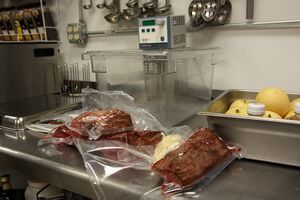Sous vide cooking



Sous-vide, French for "under vacuum", is a method of cooking food sealed in airtight plastic bags in a water bath for a long time—72 hours is not unusual—at an accurately determined temperature much lower than normally used for cooking, typically around 60 °C or 140 °F. The intention is to maintain the integrity of ingredients.
Principals
The primary feature of sous-vide is the use of temperatures much lower than for conventional cooking. The exclusion of air is secondary; it has the purposes of allowing cooked food to be stored, still sealed and refrigerated, for considerable times, useful for the catering industry but less so for domestic use; and to exclude oxygen from food that requires long cooking and is susceptible to oxidation, e.g., fat on meat which may become rancid with prolonged exposure to air.
Current proponents
The sous-vide method is used in several gourmet restaurants under Heston Blumenthal, Paul Bocuse, Michael Carlson, Thomas Keller, Ferran Adrià, Joël Robuchon, Alessandro Stratta, Charlie Trotter, and others.
Sous vide at home
Because of the high cost of sous vide cooking equipment, sous vide cooking was out of reach of most non-professional cooks. this is beginning to change as reasonably priced sous vide cookers are beginning to appear on the domestic market.
Time required
Cooking time is often not at always critical, within limits, as the temperature is not high enough to change the nature of the food rapidly. For example fish, which becomes dry very quickly if cooked conventionally for a little longer than necessary, will remain in perfect condition for a significant time.
Safety
Clostridium botulinum bacteria can grow in food in the absence of oxygen and produce the deadly botulinum toxin, so sous-vide cooking must be performed under carefully controlled conditions to avoid botulism poisoning. Generally speaking, food that is heated and served within four hours is considered safe, but meat that is cooked for longer to tenderise it must reach a temperature of at least 131 °F (55 °C) within four hours and then be kept there, in order to pasteurise the meat. Pasteurisation kills the botulism bacteria, but the possibility of hardy botulism spores surviving and reactivating once cool remains a concern as with many preserved foods, however processed.
Extra precautions need to be taken for food to be eaten by people with compromised immunity. Pregnant women may choose to be more careful than usual.